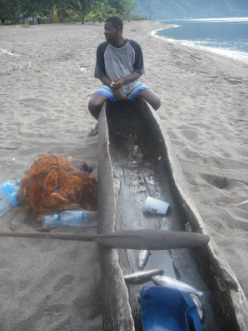
|
|
Tanzania: Past and Recent History
DNA lineages in Tanzania are amongst the oldest on Earth.
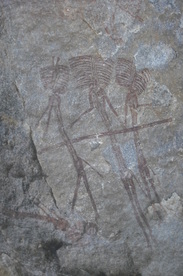
Kondoa Rock Art,
4,000yrs old
The "Cradle of Civilization"
The Rift Valley which passes through Tanzania was formed 20 million years ago and even today has migrations of millions of mammals. In the 1970s, the Leakey's found humanoid footprints there that are 3.6 million years old.
Bones and axes have been found that date back 1.8million years. Stone Age tools found near Iringa are over 60,000 yrs old. The hunter/gatherer tribes consisted of a Chief, a counsel of advisers, and up to 1000 people. The huge migration through the Rift Valley provided food for all, and the people were benevolent and flexible. Time saw many different migrations of people-both from the south of Africa and from Persia. Phoenicians came in 600 BC; a Greek merchant wrote the first travel guide in 60 AD; Roman coins have been found from the 4th century, and the Persians were trading slaves, gold and ivory from here in the 9th century. Zulu warriors from the south of Africa threatened in the early 1800's. Arabs dominated the coast until the arrival of European colonialists in the mid 1800's. First Germany, then Britain subjugated the people and confiscated their land. The local population was used for labour and discriminated against. Few inhabitants had an opportunity for an education, but in 1952 a determined visionary from Lake Victoria returned home. Julius Nyerere had started school at age 12 in a mission school,gone to Uganda for a teaching degree,and then to Scotland where he earned a Masters degree in history and economics. And he had a dream. He joined a group that was struggling for independence. By 1964, at the age of 39 he was elected President of the new Republic of Tanganyika. The entire country had a total of 120 university graduates. There were 2 lawyers, 2 engineers, and 12 medical doctors. Nyerere was an idealist with moral integrity, who strove for the betterment of his people. Today, Tanzania is one of the few peaceful countries in Africa, and is home to 120 different tribes. More than 20% of Africa's large mammal population is found in Tanzania, and parks have been created in 25% of the country for their preservation. This has resulted in the loss of a traditional way of life for the now 40 million inhabitants. They are now primarily agrarian: subsistence farmers with average annual earnings of $350.00 American.
The Rift Valley which passes through Tanzania was formed 20 million years ago and even today has migrations of millions of mammals. In the 1970s, the Leakey's found humanoid footprints there that are 3.6 million years old.
Bones and axes have been found that date back 1.8million years. Stone Age tools found near Iringa are over 60,000 yrs old. The hunter/gatherer tribes consisted of a Chief, a counsel of advisers, and up to 1000 people. The huge migration through the Rift Valley provided food for all, and the people were benevolent and flexible. Time saw many different migrations of people-both from the south of Africa and from Persia. Phoenicians came in 600 BC; a Greek merchant wrote the first travel guide in 60 AD; Roman coins have been found from the 4th century, and the Persians were trading slaves, gold and ivory from here in the 9th century. Zulu warriors from the south of Africa threatened in the early 1800's. Arabs dominated the coast until the arrival of European colonialists in the mid 1800's. First Germany, then Britain subjugated the people and confiscated their land. The local population was used for labour and discriminated against. Few inhabitants had an opportunity for an education, but in 1952 a determined visionary from Lake Victoria returned home. Julius Nyerere had started school at age 12 in a mission school,gone to Uganda for a teaching degree,and then to Scotland where he earned a Masters degree in history and economics. And he had a dream. He joined a group that was struggling for independence. By 1964, at the age of 39 he was elected President of the new Republic of Tanganyika. The entire country had a total of 120 university graduates. There were 2 lawyers, 2 engineers, and 12 medical doctors. Nyerere was an idealist with moral integrity, who strove for the betterment of his people. Today, Tanzania is one of the few peaceful countries in Africa, and is home to 120 different tribes. More than 20% of Africa's large mammal population is found in Tanzania, and parks have been created in 25% of the country for their preservation. This has resulted in the loss of a traditional way of life for the now 40 million inhabitants. They are now primarily agrarian: subsistence farmers with average annual earnings of $350.00 American.
Industrious women 'make do' with very little.
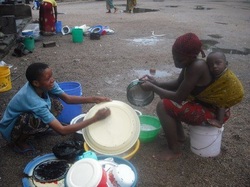
Food vendors washing up
Politics:
Nyerere wanted to provide education and health services for everyone. He broke the tribal custom by ordering people to move into villages, where services could be provided, and insisted on Swahili as a common language. Land was communal. He thought it was anti-social to accumulate personal wealth when those around you had little. A brilliant teacher, he spoke of democracy, racial equality, and the need for harmony and responsibility. In 1967, with the Arusha Declaration, the government took charge of banking and industry. Europe and North America responded by imposing economic sanctions. The impact was severe. Nyerere further displayed his unassailable integrity when, in 1975, he withdrew Tanzania from the Organization of African Unity (OAU) to protest its sanction of the murderous regime of Idi Amin in Uganda. He then raised an army and defeated Amin. The full economic burden of the war was carried by Tanzania. The country experienced further shortages and much suffering. In 1985, Nyerere stepped down. Tanzania was the 5th poorest nation in the world. The IMF placed pressure on the next regime to adopt an open market economy. There was an influx of foreign aid with many strings attached. The civil service was dismantled, with a consequential loss of teachers and health care workers. Public assets were sold at bargain prices. Large sums of money were loaned for projects that failed. Today the country staggers under a huge debt, and resources are exploited by some corrupt officials. But tribal rivalries are non existent, there is religious tolerance, people are polite and independent and cheerful. The community acts like an extended family: they follow the ancient laws of sharing.
Refugees:
Refugees from neighbouring nations have been welcomed by Tanzania. There are 1/2 million refugees in Tanzania, more than in any other country in Africa. Most live in camps along the Western border. The door has always been open to civilians fleeing violence. They have come from Uganda, Burundi, Congo, Mozambique. This has placed population pressure on the only peaceful African nation. The International Criminal Tribunal for Rwanda is held in Arusha.
Nyerere wanted to provide education and health services for everyone. He broke the tribal custom by ordering people to move into villages, where services could be provided, and insisted on Swahili as a common language. Land was communal. He thought it was anti-social to accumulate personal wealth when those around you had little. A brilliant teacher, he spoke of democracy, racial equality, and the need for harmony and responsibility. In 1967, with the Arusha Declaration, the government took charge of banking and industry. Europe and North America responded by imposing economic sanctions. The impact was severe. Nyerere further displayed his unassailable integrity when, in 1975, he withdrew Tanzania from the Organization of African Unity (OAU) to protest its sanction of the murderous regime of Idi Amin in Uganda. He then raised an army and defeated Amin. The full economic burden of the war was carried by Tanzania. The country experienced further shortages and much suffering. In 1985, Nyerere stepped down. Tanzania was the 5th poorest nation in the world. The IMF placed pressure on the next regime to adopt an open market economy. There was an influx of foreign aid with many strings attached. The civil service was dismantled, with a consequential loss of teachers and health care workers. Public assets were sold at bargain prices. Large sums of money were loaned for projects that failed. Today the country staggers under a huge debt, and resources are exploited by some corrupt officials. But tribal rivalries are non existent, there is religious tolerance, people are polite and independent and cheerful. The community acts like an extended family: they follow the ancient laws of sharing.
Refugees:
Refugees from neighbouring nations have been welcomed by Tanzania. There are 1/2 million refugees in Tanzania, more than in any other country in Africa. Most live in camps along the Western border. The door has always been open to civilians fleeing violence. They have come from Uganda, Burundi, Congo, Mozambique. This has placed population pressure on the only peaceful African nation. The International Criminal Tribunal for Rwanda is held in Arusha.
Subsistence farming is the way of life for 2/3 of the people
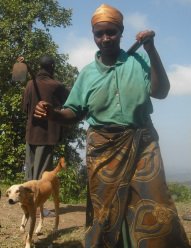
Health:
Life expectancy is 50.7 years. Clinics are free, but medication is not. Many people visit a herbalist or traditional doctor. People are generally in excellent physical shape due to their active lifestyle.
Infancy:
The infant mortality rate is high, and children are often malnourished as a result of a poorly balanced diet. Malaria is very common, as is tuberculosis. Polygamy is still very prevalent, so women do not all have male support to help with child rearing. Family planning is on the increase, but large families are still the norm.
Aids:
The infection rate of 7% is half that of South Africa. About 55% of those with HIV are women. Many children have been orphaned as a result and are cared for by the extended family. It is not an openly discussed topic, and more education is slowly spreading. Women are often expected to give sexual favours to hold down a job, and young girls are at risk of exploitation.
Life expectancy is 50.7 years. Clinics are free, but medication is not. Many people visit a herbalist or traditional doctor. People are generally in excellent physical shape due to their active lifestyle.
Infancy:
The infant mortality rate is high, and children are often malnourished as a result of a poorly balanced diet. Malaria is very common, as is tuberculosis. Polygamy is still very prevalent, so women do not all have male support to help with child rearing. Family planning is on the increase, but large families are still the norm.
Aids:
The infection rate of 7% is half that of South Africa. About 55% of those with HIV are women. Many children have been orphaned as a result and are cared for by the extended family. It is not an openly discussed topic, and more education is slowly spreading. Women are often expected to give sexual favours to hold down a job, and young girls are at risk of exploitation.
Education - a window of hope

Education:
Schools are free for Tanzanian children until grade five. Formal education ends at age 10, often sooner as the children are needed to assist with family survival chores. 20% will drop out before they finish elementary school. Only 5% of those in elementary will finish secondary school. Most cannot afford the cost of $100.00/year. And the added challenge of having all subjects in English makes success very unlikely. With marginal farmland, and little education, most children are faced with a life of poverty. Practical gardening skills and knowledge encourage hope and self reliance.
Schools are free for Tanzanian children until grade five. Formal education ends at age 10, often sooner as the children are needed to assist with family survival chores. 20% will drop out before they finish elementary school. Only 5% of those in elementary will finish secondary school. Most cannot afford the cost of $100.00/year. And the added challenge of having all subjects in English makes success very unlikely. With marginal farmland, and little education, most children are faced with a life of poverty. Practical gardening skills and knowledge encourage hope and self reliance.
Challenges to quality of living
Clearing Land by burning
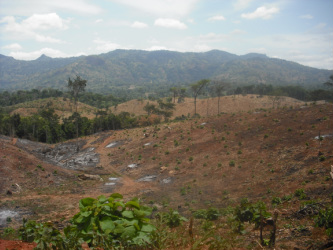
Deforestation:
This was once a rain forest in a park in northern Tanzania. It has been burned to clear it, and teak trees have been planted, as they will produce a better income. Education is needed to introduce concepts such as mulching, companion planting, natural fertilizers, and terracing. Population pressures are great in this area. Parks are being threatened by expanding communities with the real needs of feeding a family.
This was once a rain forest in a park in northern Tanzania. It has been burned to clear it, and teak trees have been planted, as they will produce a better income. Education is needed to introduce concepts such as mulching, companion planting, natural fertilizers, and terracing. Population pressures are great in this area. Parks are being threatened by expanding communities with the real needs of feeding a family.
Road repair in a rural area
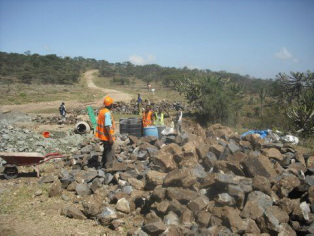
Manual labour achieves the impossible
Transportation of people and goods:
Roads are often made primarily with manual labour. Even the gravel is broken by hand. Heavy equipment is used on major projects, but large projects are often contracted out to foreign companies. Tanzanian roads are prone to erosion, and traffic hold-ups. Inter town commerce and the transportation of goods and services can be hugely challenging. Buses, the mode of travel for most people, are crowded and often kept running by an on-board mechanic. There is always room for one more person or another bundle or box. Flat tires are a common result of rocks and holes in the poorly maintained streets and roads. Despite these difficulties, there is always a bus or van to get you wherever you need to go, at a reasonable fare. People endure the inconveniences with resilience and good humour .
Roads are often made primarily with manual labour. Even the gravel is broken by hand. Heavy equipment is used on major projects, but large projects are often contracted out to foreign companies. Tanzanian roads are prone to erosion, and traffic hold-ups. Inter town commerce and the transportation of goods and services can be hugely challenging. Buses, the mode of travel for most people, are crowded and often kept running by an on-board mechanic. There is always room for one more person or another bundle or box. Flat tires are a common result of rocks and holes in the poorly maintained streets and roads. Despite these difficulties, there is always a bus or van to get you wherever you need to go, at a reasonable fare. People endure the inconveniences with resilience and good humour .
Markets flourish in rural areas
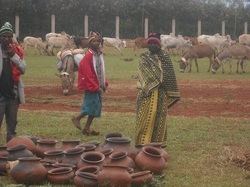
A market economy
Local Commerce - Promoting peace with prosperity:
The weekly market is a chance for crafts persons to exchange ideas as well as goods. It is also a social time. Food, drink and laughter are all part of business. Pleasantries and formalities are a forerunner to business exchanges. People often travel long distances on trucks or buses with their bags and crates roped on top. If they lack a stall, they will display their wares on the ground. Barter is still common, and in remote areas the cash flow is very small.
The weekly market is a chance for crafts persons to exchange ideas as well as goods. It is also a social time. Food, drink and laughter are all part of business. Pleasantries and formalities are a forerunner to business exchanges. People often travel long distances on trucks or buses with their bags and crates roped on top. If they lack a stall, they will display their wares on the ground. Barter is still common, and in remote areas the cash flow is very small.
Traditional Subsistence
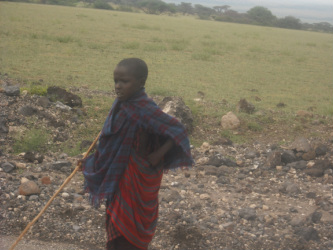
Those retaining a traditional lifestyle often live a long walk from a village. Children may get to school, or they may spend their childhood herding cattle: making sure they don't eat someone's corn, and getting them down for a drink somewhere before taking them home at the end of the day. At a young age, they will be expected to help with daily chores-hoeing in the fields, fetching firewood. Girls are very young when they learn how to light a fire, help with food preparation, and tend younger children. Before puberty, they may be circumcised and promised to someone in marriage. When a second wife enters the family compound, the first wife must build the house for her. Houses usually are without windows, made of cane, mud and dung with a thatched roof. A fire on the earthen floor in one corner constitutes the kitchen. Low stools and a low cane sleeping platform are the only furniture. Corn fields surrounding the compound provide the main diet. The corn is dried, then ground and boiled to a thick porridge and eaten with a sauce of meat or beans. Water may have to be carried from a distant place. If a mule or bicycle is not available, the women and girls will carry it on their head. It is a simple life, and a hard one. As the global climate changes, lives like these are at risk. A long drought that ruins the harvest or kills the cattle means sickness and starvation.
Students are eager to learn
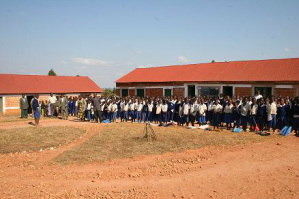
Classes are large and teachers poorly paid
Education:
Children receive free education for the first 5 years. It then costs about $100.00/yr.to attend secondary school, and they must be fluent in English.
Teachers are poorly paid and schools are not well equipped (no water or electricity). Being better educated means being better prepared for life's challenges. Education is one of the fundamental building blocks for world peace.
It is where we must put energy and resources.
Children receive free education for the first 5 years. It then costs about $100.00/yr.to attend secondary school, and they must be fluent in English.
Teachers are poorly paid and schools are not well equipped (no water or electricity). Being better educated means being better prepared for life's challenges. Education is one of the fundamental building blocks for world peace.
It is where we must put energy and resources.
Tanzania has a highly motivated young population
All they require is a chance
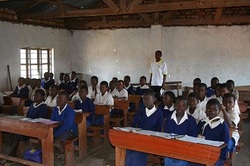
Students at Katesh elementary school
Our goal at SOAS:
To provide the opportunity for hands-on learning in permaculture, soil science, mathematics, English and commerce, and to enable the children to earn money for school.
To provide the opportunity for hands-on learning in permaculture, soil science, mathematics, English and commerce, and to enable the children to earn money for school.
Integrated farming
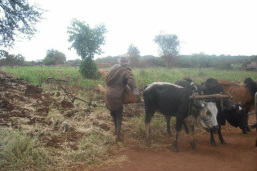
Cattle are part of the work force
The future of sustainability:
Cattle are valued for the work they do, the food they provide, the electricity they produce and for the status they give. They are like money in the bank. Although there are seldom any fences in the countryside, there are large herds of cattle. They are tended by women or children, and taken home each evening. If kept in pens, their manure can be collected and the methane gas used to provide light in homes during the long evenings. Some are harnessed to carts, and used to carry loads. If a man wants a wife, he uses cattle as a dowry. The animals are very accustomed to people, unlike the majority of cattle in North America. Small holdings can provide all a family requires, with poultry, pork, fruit, vegetables, honey, fish(in ponds) and beef.
Cattle are valued for the work they do, the food they provide, the electricity they produce and for the status they give. They are like money in the bank. Although there are seldom any fences in the countryside, there are large herds of cattle. They are tended by women or children, and taken home each evening. If kept in pens, their manure can be collected and the methane gas used to provide light in homes during the long evenings. Some are harnessed to carts, and used to carry loads. If a man wants a wife, he uses cattle as a dowry. The animals are very accustomed to people, unlike the majority of cattle in North America. Small holdings can provide all a family requires, with poultry, pork, fruit, vegetables, honey, fish(in ponds) and beef.
Solar dehydration-the ancient art of preserving
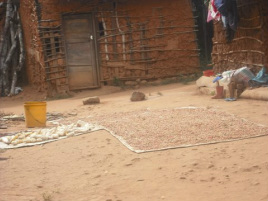
Corn being dried in a courtyard
Small gardens:
With the global sourcing of food supply, a major disruption in transportation, such as peak oil, could have a serious outcome. Food shortages result in higher prices. High prices place great numbers of people under stress, particularly in developing nations. Stress produces civil unrest. Small gardens are an answer to the challenge. Yet not everyone has gardening skills. In this small courtyard, corn has been harvested and is drying in the sun. It will be stored in tight plastic buckets and ground before being boiled. There are many foods more nutritious than corn, but these people do not have the seeds or the knowledge to grow them. With education and a new direction, their lives will be healthier. Here in Canada, we must learn the importance of growing our own food and saving seeds.
With the global sourcing of food supply, a major disruption in transportation, such as peak oil, could have a serious outcome. Food shortages result in higher prices. High prices place great numbers of people under stress, particularly in developing nations. Stress produces civil unrest. Small gardens are an answer to the challenge. Yet not everyone has gardening skills. In this small courtyard, corn has been harvested and is drying in the sun. It will be stored in tight plastic buckets and ground before being boiled. There are many foods more nutritious than corn, but these people do not have the seeds or the knowledge to grow them. With education and a new direction, their lives will be healthier. Here in Canada, we must learn the importance of growing our own food and saving seeds.
Fishing sustainably
|
These waters have fed multitudes for millennia In addition to the Indian Ocean, Tanzania has many lakes. Three are particularly noteworthy as they can boast the largest diversity of fish in the world. Lake Victoria, on the northern boarder, is the second largest freshwater body in the world (surpassed only by Lake Superior in Canada). Unhappily, it has been invaded by foreign entrepreneurs who have introduced a non native species that has upset the balance and is devouring other species. That plus over fishing, pollution from agricultural projects and raw sewage from habitation have combined to ring the death knoll for Lake Victoria. Then there is the jewel-Lake Tanganyika. It is the longest freshwater body in the world, and the second deepest after Lake Baikal in Russia. It is 3 million years old, and has the lowest pollution of any lake in the world. It hosts 500 species of fish. And lastly, there is Lake Nyasa, inaccessibly nestled in the Rift Valley, reputed to be the most beautiful lake in Africa. Perhaps the presence of cerebral malaria in the area has kept it safe! |
We must protect what we have to ensure sustainability
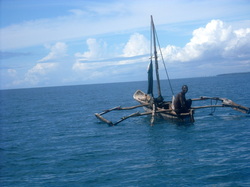
Fishing in the Indian Ocean off Pangani, Tanzania
When boats are small and the catch is small there is no damage to the resource. But when Big Business decides to "clean up'", that is exactly what happens. They get wealthy at the expense of sustainability, and future generations.
The Real Safari happens here
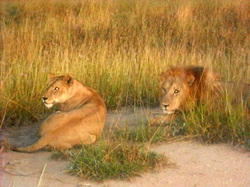
For a tourist, Tanzania has the stuff of dreams. Endless plains teaming with game, beautiful lakes and beaches, ancient ruins, big apes, memorable markets, tropical splendor and misty mountains. Game parks are plentiful though rather expensive to visit. On the positive side, the fees for the parks go into health care and education. Tanzania is a land with great potential for her future generations. It is also a nation that needs support from the developed world. The animals may be the reason you visit Tanzania but it will be the people you remember.
For more information see www.zasafrica.com
For more information see www.zasafrica.com
Help reforest the cradle of civilization . . . . .
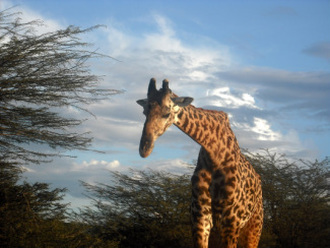
. . . . Our ancestors helped to rob it.
YOU can help School Orchards Africa
to equip the next generation of Tanzanians
with skills and hope for their future.
Donate by using the CanadaHelps link on our
Donations Page.
